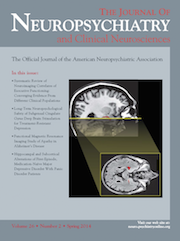To the Editor: Catatonia is a neuropsychiatric syndrome characterized by concurrent motor, emotional, vegetative, and behavioral symptoms.
1 Even though it was initially conceptualized as a subtype of schizophrenia, subsequently it was reported to occur not only with other psychiatric conditions but also with various medical and neurological conditions. Here we report a case of possible organic catatonia because of small vessel brain ischemic changes in basal ganglia in an elderly person with inadequate response to conventional treatment options.
Case Report
A 60-year-old man presented in December 2012 with a 4-year history of illness with fluctuating course of catatonic symptoms characterized by withdrawn behavior, mutism, posturing, negativism, rigidity, and tremors, in addition to occasional reporting of low mood. The patient was evaluated during his first presentation to hospital, and his biochemistry parameters, such as fasting blood sugar, liver function test, renal function test, and serum electrolytes were normal. The score on Busch Francis Catatonia Rating scale (BFCRS) at the time of presentation was 18.
Previously, the patient had a history of failure to improve on a trial of lorazepam and three sessions of ECT. During the index in-patient care in our hospital, he was started on risperidone 4 mg/day, escitalopram 20 mg/day, and trihexyphenidyl 2 mg/day. We also initiated ECT (total eight sessions) in view of catatonic symptoms and poor oral intake. With the above treatment, the patient showed a 50%−60% improvement with residual catatonic symptoms. BFCRS scores dropped down to 5 at this point.
However, 2 months after discharge, the patient again started having progressive catatonic symptoms in the form of withdrawn behavior, mutism, posturing, rigidity, negativism, automatic obedience, and reduced oral intake, with BFCRS score reaching 17. In view of incomplete remission of catatonic symptoms in the elderly, MRI brain was performed. MRI fluid-attenuated inversion recovery (FLAIR) images revealed foci of hyperintensities in subcortical structure and deep white matter of central semiovale in addition to the head of right caudate nucleus suggesting the possibility of small vessel ischemic changes. In view of the evidence for vascular lesions in critical subcortical structures, a possibility of organic catatonia was considered. Subsequent treatment with nine ECT sessions, patient showed partial improvement, with BFCRS score reaching 4. The recovery was not complete and residual symptoms in the form of withdrawn behavior, reduced speech, and reduced activity levels remained.
Discussion
It has been documented that a significant proportion of the patients with catatonia have ‘organic’ underpinning.
2 Organic catatonic disorder can occur in a wide range of neurological disorders involving basal ganglia, limbic system, and cortex.
3 Basal ganglia structures, especially the caudate nucleus, forms an important element in the motor-behavior circuit.
4 A previous report on brain blood flow changes indicated baseline hypoperfusion of striatum in an elderly subject with catatonia.
5 Thus, small vessel ischemic changes involving striatum as described in the present report can be a potential explanation to the catatonic syndrome. Such “demonstrable” organic lesions could predict poorer response to conventional treatment methods as is evident in this case.

